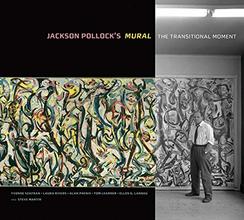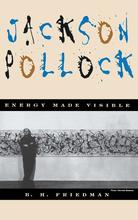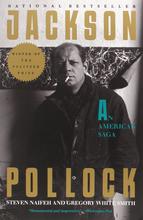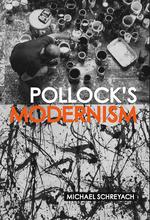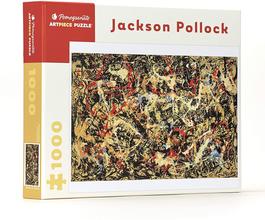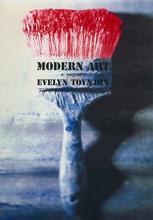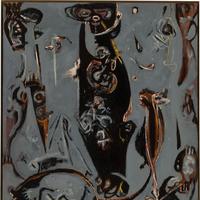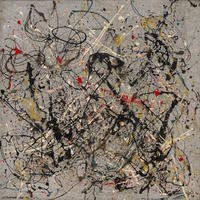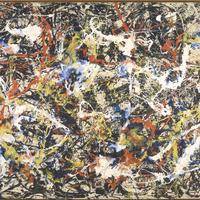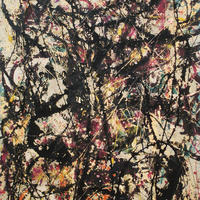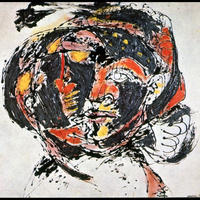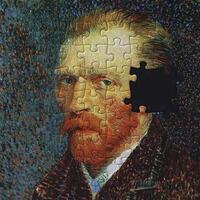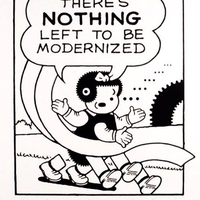More about Jackson Pollock
- All
- Info
- Shop
Works by Jackson Pollock

Contributor
(Paul) Jackson Pollock was the epitome of the crazy, moody, stupendously creative artist label.
Jackson Pollock is probably the artist that helped permanently set this archetype in our cultural conscious. He drank, smoked, philandered and occasionally liked to paint. With that creative and crazy mentality, it didn’t help that Pollock cemented his artistic martyrdom with his death. He was driving drunk, with his mistress in the car, and decided to challenge a tree to a game of chicken. The tree won. Like the musician (another type of artist persona) who overdoses or commits suicide we place them on a pedestal and have a fondness for them. We romanticize someone troubled, but when they were in this world they made us uncomfortable.
Pollock was an outcast throughout his childhood and didn’t finish high school. He literally was a starving artist: stealing food and gas, painting in chicken coops because there was nowhere else, and he wasn’t even able to attend his father’s funeral because of lack of funds. He also baby sat for Thomas Hart “Old Bullion” Benton, receiving milk and food for payment.
In the late 1930s as a young man, he studied another “crazy artist,” Mr. Picasso. He was inspired by the sheer size, idea, and expressionism of Guernica. Pollock filled sketchbooks full of his Guernica studies.
He married fellow artist Lee Krasner, who was there for his dysfunctional self whenever he was too drunk or depressed to function. It stunted her career partly because she was a capable artist next to someone whom people considered a genius, and his destructive personality inevitably tried to sink her. Though his death (and the mistress' survival) was a slight to her, she displayed her strength, championed her late husband, and eventually returned to painting for herself.
One of the key artists of Abstract Expressionism, Pollock’s splatter paint style is undeniably his and something that, if emulated, is instantly referred back to him. He was unorthodox – he didn’t use an easel or wall, instead laying his canvases on the floor (but that might have been for practicality); he believed in the bigger the better. Since he was consistently broke he used house paint. He hardly used brushes, preferring knives or sticks to drip the paint.
In Hollywood, Ed Harris performed phenomenally as Pollock in Pollock (2000) . Harris immersed himself in the character, literally also trying to copy his techniques and actions that he could emulate through films and photos of Pollock. Harris commented "One thing I learned about Mr. Pollock's art, which any art student knows I'm sure, but was indeed a revelation to me, is that Jackson fully believed and lived by 'don't use the accident, because I deny the accident'. One cannot even approximate Pollock's work unless every stroke, every pour, every slap, every fling, every shake, every splash, every splatter and every flick has a specific intention".
Featured Content
Here is what Wikipedia says about Jackson Pollock
Paul Jackson Pollock (/ˈpɒlək/; January 28, 1912 – August 11, 1956) was an American painter. A major figure in the abstract expressionist movement, Pollock was widely noticed for his "drip technique" of pouring or splashing liquid household paint onto a horizontal surface, enabling him to view and paint his canvases from all angles. It was called all-over painting and action painting, since he covered the entire canvas and used the force of his whole body to paint, often in a frenetic dancing style. This extreme form of abstraction divided the critics: some praised the immediacy of the creation, while others derided the random effects. In 2016, Pollock's painting titled Number 17A was reported to have fetched US$200 million in a private purchase.
A reclusive and volatile personality, Pollock struggled with alcoholism for most of his life. In 1945, he married the artist Lee Krasner, who became an important influence on his career and on his legacy. Pollock died at age 44 in an alcohol-related single-car collision when he was driving. In December 1956, four months after his death, Pollock was given a memorial retrospective exhibition at the Museum of Modern Art (MoMA) in New York City. A larger, more comprehensive exhibition of his work was held there in 1967. In 1998 and 1999, his work was honored with large-scale retrospective exhibitions at MoMA and at the Tate in London.
Check out the full Wikipedia article about Jackson Pollock


